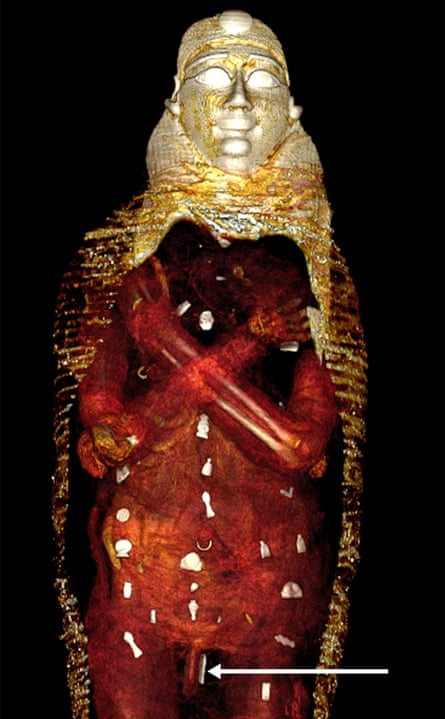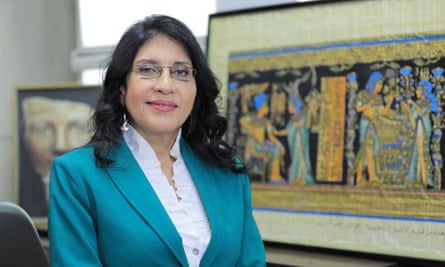A new digital scan has revealed intimate details about a teenage boy who was mummified about 2,300 years ago.
A team of scientists led by Sahar Saleem, a professor of radiology at the faculty of medicine at Cairo University, concluded that the boy and his family were rich and of high social status because his body was adorned with 49 precious amulets.
Saleem said: “Many were made of gold, while some were made of semi-precious stones, fired clay or faience. Their purpose was to protect the body and give it vitality in the afterlife.”
The team dubbed the mummy the Golden Boy. He was first discovered in 1916 at a cemetery used from 332BC to 30BC in Nag el-Hassay in southern Egypt. Until now it had been stored unexamined in the basement of Cairo’s Egyptian museum.
The amulets on the body included a golden heart scarab stuck down his throat and a golden tongue inside his mouth.
Saleem said the amulets were “beautifully stylised in a unique arrangement of three columns between the folds of the wrappings and inside the mummy’s body cavity. These include the eye of Horus, the scarab, the akhet amulet of the horizon, the placenta, the knot of Isis and others.”
Saleem and her team used CT scans to allow them to examine the inside of mummies without unwrapping them.

The study estimated that the boy was about 14 or 15 years old, based on the degree of bone fusion in his skeleton and the absence of wisdom teeth in his mouth. Using recents advances in CT scans, the study also established that he was uncircumcised.
According to experts this is relatively rare in mummies and suggests the teenager may not have been Egyptian, which could add to evidence that outsiders may also have been mummified.
Commenting on the study, Prof Salima Ikram, head of Egyptology at the American University in Cairo, said: “The lack of circumcision is interesting as it might tell us something about his ethnicity – Egyptians tended to be circumcised generally before the age of 13.”
Ikram, who was not involved in the study, added: “It might suggest that foreigners adopted Egyptian burial practices – and we know the Persians did.
“He could have come from any number of places. He could be Nubian, Greek, Persian, anywhere from Asia Minor where they weren’t circumcised. What we can say is he probably wasn’t Jewish.”

She pointed out that only the latest CT scans can pick up this level of detail on a mummified body. But she cautioned: “I wouldn’t hang all of this on one fragile foreskin.”
One of the amulets discovered in the study was in the shape of two fingers and placed next to the boy’s penis.
According to the British Museum, such amulets represent the hand of the embalmer. Saleem’s team said it was placed near the embalming incision in the belief that this would help the body heal in the afterlife.
But Ikram is less certain of this interpretation. She said: “Two-fingered amulets appear in other parts of the body. We don’t really know what it represents.
“You could interpret it as being the hands of the midwife when she uses two fingers to take mucus out of a child’s mouth. According to Egyptians, when you die you are reborn.”
She added: “For Egyptians, the mummification process was a metamorphosis, when you went from being a human to a divine beings, and the flesh of the gods is of gold.”
The scans revealed the boy was wearing sandals. Saleem said: “The sandals were probably meant to enable the boy to walk out of the coffin. According to the ancient Egyptians’ ritual Book of the Dead, the deceased had to wear white sandals to be pious and clean before reciting its verses.”
Ikram praised the detail of the research. “It’s very nice to have a study with this level of detail. It is part of building up a larger dataset for Egyptologists to better understand the lives of ancient people and their religious and cultural beliefs.”

 1 year ago
109
1 year ago
109










 English (US)
English (US)